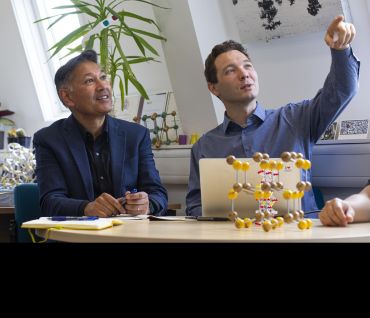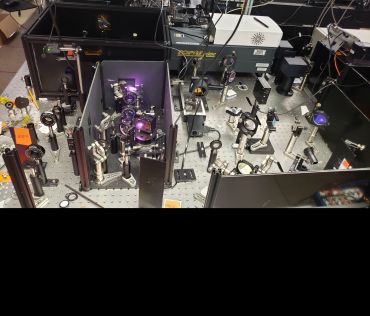
Innovative technique reveals that leaping atoms remember where they have been
University of Oxford researchers have used a new technique to measure the movement of charged particles (ions) on the fastest ever timescale, revealing new insights into fundamental transport processes. These include the first demonstration that the flow of atoms or ions possesses a ‘memory.’ The results have been published in the journal Nature.
 Professor Saiful Islam (left) and Dr Andrey Poletayev (right). Image credit: Dominic Grantley-Smith/Faraday Institution.
Professor Saiful Islam (left) and Dr Andrey Poletayev (right). Image credit: Dominic Grantley-Smith/Faraday Institution.In the new study, a team of researchers based at Oxford’s Department of Materials and the SLAC National Accelerator Laboratory, California made the surprising discovery that the movement of individual ions can be influenced by its recent past; in other words, there is ‘a memory effect.’ This means that, on the microscopic scale, history can matter: what a particle did a moment ago can affect what it does next.
Up to now, this has been extremely challenging to observe because such an effect is unnoticeable by simple observation. To test whether ion movement has a memory, something unusual must be introduced: disturb the system, and then watch how the disturbance dies down.
Senior author Professor Saiful Islam (Department of Materials, University of Oxford) said: ‘To use a visual analogy, such an experiment is like throwing a rock into a pond to watch how far the waves spread. But for watching atoms flow, the rock in our study must be a pulse of light. Using light, we have captured the movement of ions on the fastest-ever timescale, revealing the link between the individual movement of atoms and macroscopic flow.’
 The setup of the laser used in the experiment, in the laboratory of Dr Matthias Hoffmann at SLAC National Accelerator Laboratory in California. Image credit: Dr Andrey Poletayev.
The setup of the laser used in the experiment, in the laboratory of Dr Matthias Hoffmann at SLAC National Accelerator Laboratory in California. Image credit: Dr Andrey Poletayev.In order to capture this, the team used a technique called pump-probe spectroscopy, using rapid, intense pulses of light to both trigger and measure the ions’ movement. Such nonlinear optical methods are commonly used to study electronic phenomena in applications from solar cells to superconductivity, but this was the first time it has been used to measure ionic motions without involving electrons.
Lead author Dr Andrey Poletayev (Department of Materials, University of Oxford, and formerly SLAC National Accelerator Laboratory) said: ‘We found something interesting, which happened a short time after the ion motions we triggered directly. The ions recoil: if we push them to the left, they then preferentially reverse to the right afterwards. This resembles a viscous substance being jerked rapidly then relaxing more slowly - like honey. This means that for a time after we pushed the ions with light, we knew something about what they would do next.’
Besides the implications for materials discovery, this work disabuses the notion that what we see on the macroscopic level – transport that appears memory-free – is directly replicated at the atomic level.
Dr Andrey Poletayev, Department of Materials, University of Oxford.
The researchers were only able to observe such an effect for a very short time, a few trillionths of a second, but expect this will increase as the sensitivity of the measurement technique improves. Follow-up research aims to exploit this newfound understanding to make faster and more accurate predictions of how well materials can transport charge for batteries, and engineering new kinds of computing devices that would operate more rapidly.
According to the researchers, quantifying this memory effect will help to predict the transport properties of potential new materials for the better batteries we need for the growth in electric vehicles. However, the findings have implications for all technologies in which atoms flow or move, whether in solids or in fluids, including neuromorphic computing, desalination, and others.
Dr Poletayev added: ‘Besides the implications for materials discovery, this work disabuses the notion that what we see on the macroscopic level – transport that appears memory-free – is directly replicated at the atomic level. The difference between these scales, caused by the memory effect, makes our life very complicated, but we have now shown that it is possible to measure and quantify this.’
The study ‘The persistence of memory in ionic conduction probed by nonlinear optics’ has been published in Nature.
 Landmark study definitively shows that conservation actions are effective at halting and reversing biodiversity loss
Landmark study definitively shows that conservation actions are effective at halting and reversing biodiversity loss
 Researchers find oldest undisputed evidence of Earth’s magnetic field
Researchers find oldest undisputed evidence of Earth’s magnetic field
 Honorary degree recipients for 2024 announced
Honorary degree recipients for 2024 announced
 Vice-Chancellor's innovative cross-curricular programme celebrated
Vice-Chancellor's innovative cross-curricular programme celebrated
 New database sheds light on violence in Greek detention facilities
New database sheds light on violence in Greek detention facilities
 New study could help unlock ‘game-changing’ batteries for electric vehicles and aviation
New study could help unlock ‘game-changing’ batteries for electric vehicles and aviation